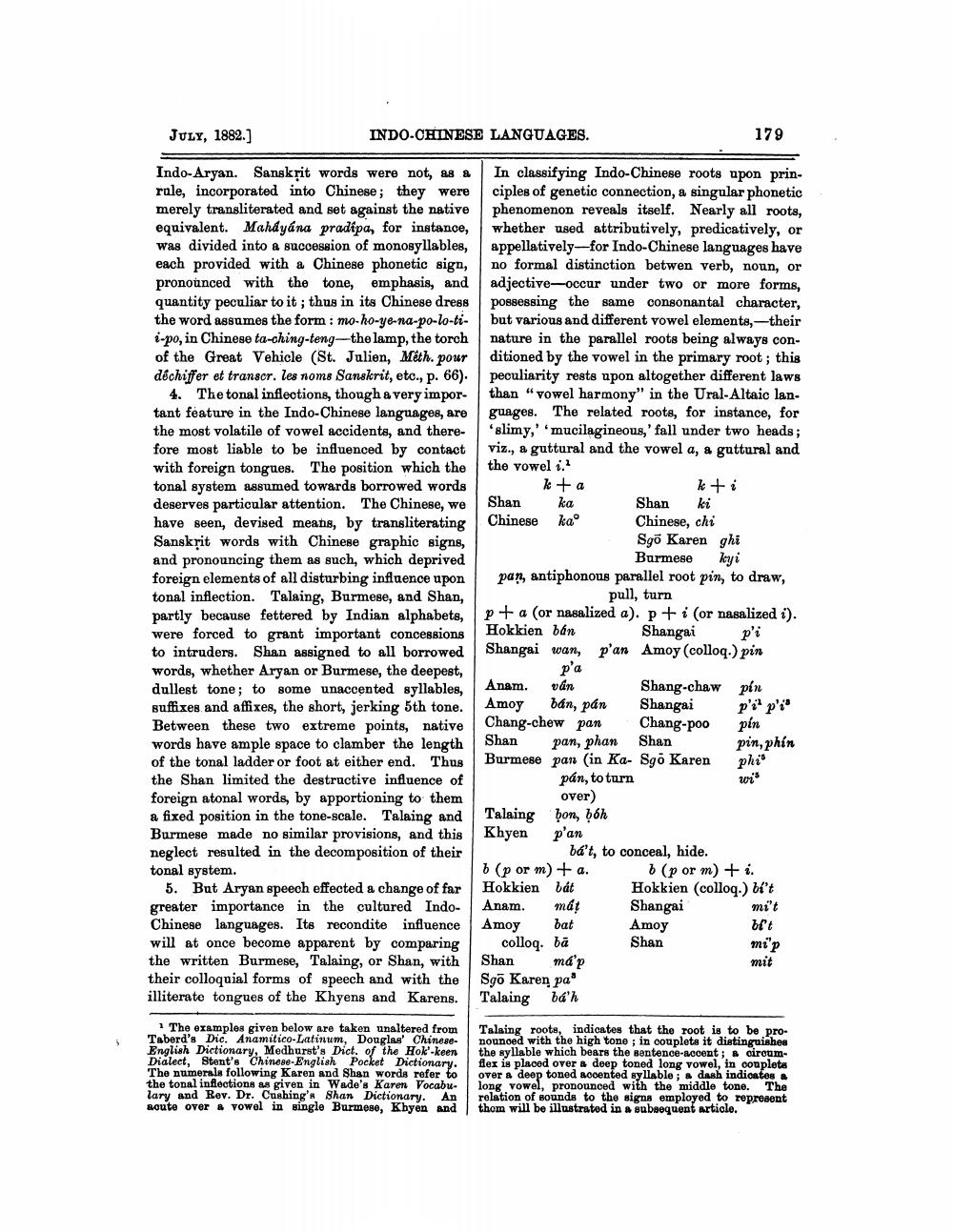________________
JULY, 1882.]
INDO-CHINESE LANGUAGES.
179
Indo-Aryan. Sanskrit words were not, as a In classifying Indo-Chinese roots upon prin. rule, incorporated into Chinese; they were ciples of genetic connection, a singular phonetic merely transliterated and set against the native phenomenon reveals itself. Nearly all roots, equivalent. Mahdyána pradipa, for instance, whether used attributively, predicatively, or Was divided into a succession of monosyllables, appellatively-for Indo-Chinese languages have each provided with a Chinese phonetic sign, no formal distinction betwen verb, noun, or pronounced with the tone, emphasis, and adjective-occur under two or more forms, quantity peculiar to it; thus in its Chinese dress possessing the same consonantal character, the word assumes the form : mo-ho-ye-na-po-lo-ti- but various and different vowel elements, their e-po, in Chinese ta-ching-teng-the lamp, the torch nature in the parallel roots being always conof the Great Vehicle (St. Julien, Méth. pour ditioned by the vowel in the primary root; this déchiffer et transcr. les noms Sanskrit, etc., p. 66). peculiarity rests upon altogether different laws
4. The tonal inflections, though a very impor- than "vowel harmony" in the Ural-Altaic lantant feature in the Indo-Chinese languages, are guages. The related roots, for instance, for the most volatile of vowel accidents, and there- slimy,' 'mucilagineous,' fall under two heads; fore most liable to be influenced by contact viz., a guttural and the vowel a, a guttural and with foreign tongues. The position which the the vowel 1. tonal system assumed towards borrowed words
k + a
kti deserves particular attention. The Chinese, we |
Shan ka
Shan ki have seen, devised means, by transliterating Chinese kao Chinese, chi Sanskrit words with Chinese graphic signs,
Sgo Karen ghi and pronouncing them as such, which deprived
Burmese kyi foreign elements of all disturbing influence upon pan, antiphonous parallel root pin, to draw, tonal inflection. Talaing, Burmese, and Shan,
pull, turn partly because fettered by Indian alphabets, 1 p + a (or nasalized a). p +i (or nasalized i). were forced to grant important concessions
Hokkien bán
Shangai p'i to intruders. Shan assigned to all borrowed Shangai wan, p'an Amoy (colloq.) pin words, whether Aryan or Burmese, the deepest,
pa dullest tone; to some unaccented syllables,
Anam. van Shang-chaw pin suffixes and affixes, the short, jerking 5th tone.
Amoy bán, pán Shangai p'in p'is Between these two extreme points, native Chang-chew pan Chang-poo pin words have ample space to clamber the length Shan pan, phan Shan pin, phía of the tonal ladder or foot at either end. Thus Burmese pan (in Ka- Sgo Karen phis the Shan limited the destructive influence of
pán, to turn foreign atonal words, by apportioning to them
over) a fixed position in the tone-scale. Talaing and Talaing bon, bóh Burmese made no similar provisions, and this Khyen p'an neglect resulted in the decomposition of their
bá't, to conceal, hide. tonal system.
b (p or m) + a. b (p or m) + . 5. But Aryan speech effected a change of far Hokkien bát Hokkien (colloq.) bi't greater importance in the cultured Indo- Anam. már Shangai
mi't Chinese languages. Its recondite influence Amoy bat
Amoy
63't will at once become apparent by comparing colloq. ba
Shan
mi'p the written Burmese, Talaing, or Shan, with Shan má p
mit their colloquial forms of speech and with the Sgo Karen pa illiterate tongues of the Khyens and Karens. Talaing ba'h
ws
_1 The examples given below are taken unaltered from Taberd's Dic. Anamitico-Latinum, Douglas' ChineseEnglish Dictionary, Medhurst's Dict. of the Hok'-keen Dialect, Stent's Chinese-English Pocket Dictionary. The numerals following Karen and Shan words refer to the tonal inflections as given in Wade's Karen Vocabu. lary and Rev. Dr. Cushing's Shan Dictionary. An Boute over a vowel in single Burmese, Khyen and
Talaing roots, indicates that the root is to be pronounced with the high tone ; in couplets it distinguishes the syllable which bears the sentence-acoent; circumflex is placed over a deep toned long vowel, in coupleta over a deep toned accented syllable; & dash indicates a long vowel, pronounced with the middle tone. The relation of sounds to the signs employed to represent thom will be illustrated in a subsequent article.




